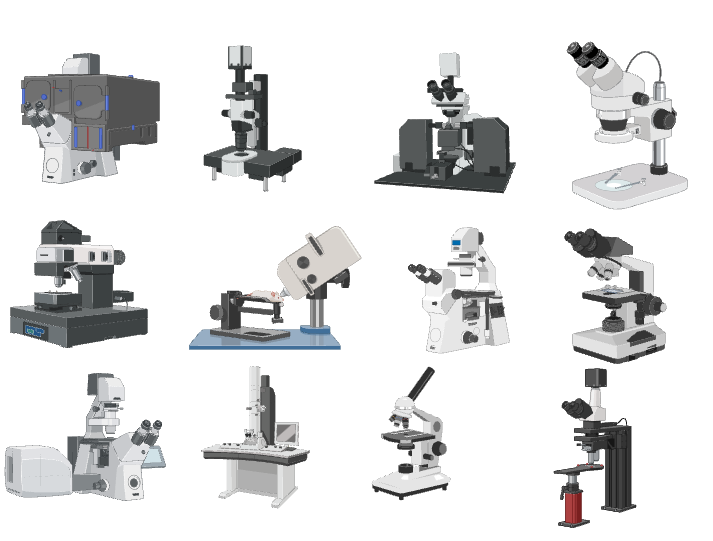Picture yourself looking into a universe so small it cannot be seen by the eyes; microscopes open that galaxy. These clever gadgets make things and samples appear bigger, showing us a lot of complex, detailed stuff that wouldn’t be perceptible to us otherwise. Be it a scientist scoping out cells, or a student awing over the veins in a leaf, microscopes have a way of enlarging the microscope.
Through the centuries microscopes have changed from primitive forms to wondrous pieces of technology. Simple microscopes – one lens, good to use for observation of low magnification things. They are like the high-tech big brothers of the magnifying glass. And there are also compound microscopes–lots of lenses–that can magnify so precisely that it would make your eyes bleed. They’re the bread and butter of labs everywhere, whether it’s a biology classroom or a cutting-edge medical research lab. However, if you wish to delve into the very small—truly the small (microscopic)—electron microscopes are the big boys. Shooting beams of electrons instead of light, these marvels obtain a mind-blowing magnification with crazy detail. It’s sort of like they’re the superheroes of the microscopy world.
It is amazing to think though that it was only back in the late 16th century that we first got microscopes. At the time, they were like little refracting telescopes with a lens tossed in strictly for ornamental purposes. Skip forward a little and there is Antonie van Leeuwenhoek, a Dutch scientist who is the Sherlock Holmes of tiny objects. And his own-fashioned compound microscopes let him discover living cells, so he turned biology upside down like a snow globe. Think of the excitement of viewing what no human ever had before – life on a previously unimagined scale.
Innovation would reach supersonic speeds by the nineteenth century. Polarizing microscopes, phase-contrast microscopes, fluorescence microscopes – these new microscopes gave us a broader study of light and let us delve deeper into living and nonliving specimens. And these were tools that gave scientists vistas never before dreamed of. Then the electron microscope of the 20th century came, the so-called progressive of progressivos. Going from binoculars to a telescope to view the surface of the moon: instead of seeing 2 people having sex 20 miles away, now it is seeing 2 amoebas having sex 20 miles away—hmmm?
But to remind you, microscopes are not just microscopes. They have uncovered the unseen world of microorganisms, enlightened our understanding of cells and tissues, and made possible many of our technological and medical advancements. They are what allow us to understand the physical world. Otherwise, we would be reading a book without light. Therefore, the next time you see a microscope, go ahead and give it a knowing wink. It’s been laboring to render the invisible visible.
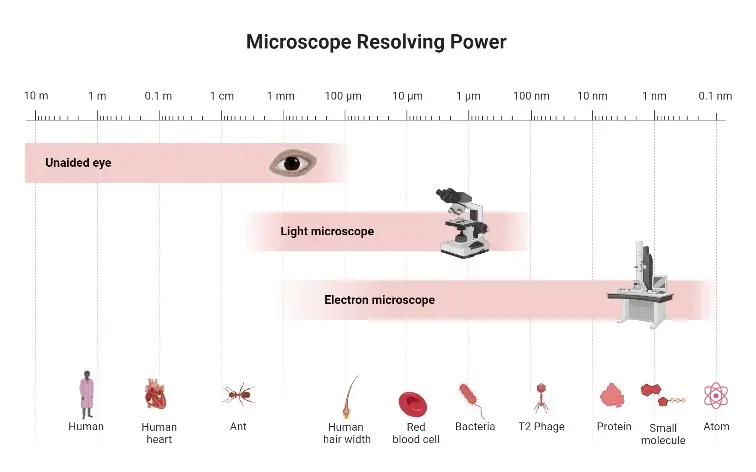
Types of microscopes
Microscopes have become specialized instruments, tailored to various requirements in research, education, and technology. The following is a summary of the primary kinds and their applications:
- Simple Microscope – It’s a simple instrument, only one lens. It’s like a magnifying glass on crack—perfect for those low magnification jobs.
- Compound Microscope – This one takes it to the next level with more lenses, offering greater magnification and better resolutions. Excellent for examining cells and tissues in the laboratory or classroom.
- Phase Contrast Microscope – Have you ever tried looking at unstained cells? This microscope uses light phase shifts to enhance transparent specimens to achieve contrast without stains.
- Fluorescence Microscope – Want to visualize fluorescent dyes or labels. This type involves using particular light wavelengths to highlight specific areas of a sample.
- Electron Microscope – Substitutes electron beams for visible light. The result? Unrivaled in magnification and resolution with which to examine submicroscopic structures such as viruses.
- Scanning electron microscope (SEM) – For producing beautiful 3D images by scanning a sample’s surface with electrons. Great study material.
- Transmission electron microscope (TEM) – Can slice samples on the atomic scale. Perfect for those scientists investigating the intricate framework of the organelles.
- Dark Field Microscope – Bright specimens on a dim background. It’s the basic observation for viewing live organisms or cells without staining.
- Stereomicroscope (dissecting microscope) – Low magnification with a 3D view – ideal for dissection of organisms or examining minute objects.
- Digital Microscope – Captures pictures and images digitally, usually with a computer monitor accompany. ‘Convenient for today’s labs and classrooms.
- Scan Probe Microscope – It uses a mechanical probe to scan over surfaces and build up an atomic-level image. A necessity for the field of nanotechnology.
- Atomic Force Microscope (AFM) – An SPM that detects surface interactions. Very suitable for the study of materials on the nano scale.
- Inverted Microscope – It rotates the lens under the stage so you can look at samples in petri dishes. This is common in cell culture labs.
- Acoustic Microscope – Images are produced of samples with sound waves. Useful in materials science and biology.
- X-Ray Microscope – Employs X-rays, not light, for imaging – great way to view thick or dense materials, etc.
- Polarizing Microscope – That is ideal for observing samples that are birefringent, such as crystals or minerals. Provides color contrast for thorough examination.
- Metallurgical Microscope – Designed specifically to examine metals and alloys. You were heavily employed in quality control or failure analysis.
- Pocket Microscope – Compact and portable. It comes in handy for field examinations.
- USB Microscope – Then it plugs into your PC, and you can view it digitally. This is fine for hobbyists or just simple documentation.
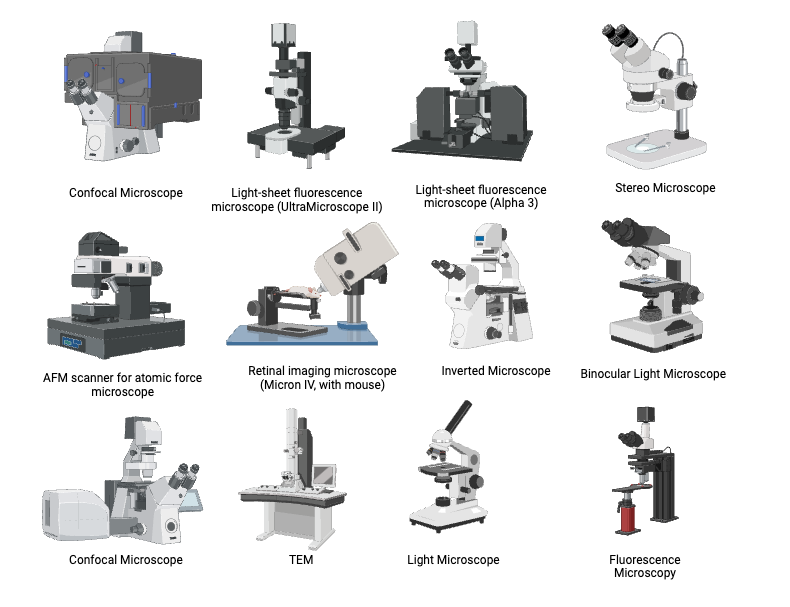
1. Simple Microscope
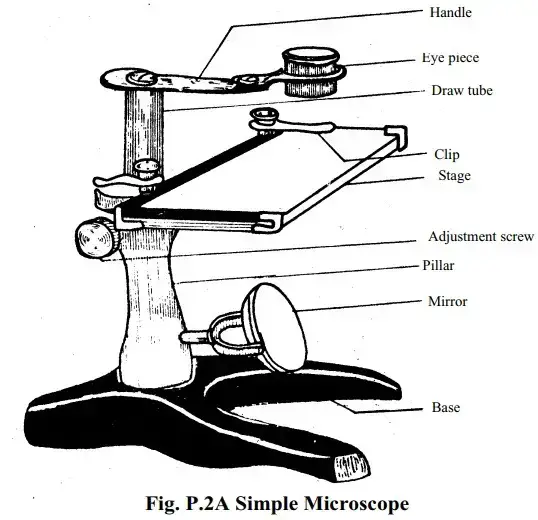
Simple microscopes, or magnifiers, have only one double convex lens with a very short focal length. Instruments like the hand lens, or magnifying glass, are included here. It is a scientific rule that when something is close to the lens, an image is created. This image, unlike the image of the original object, is upright and magnified. Keep in mind that the picture generated will be virtual. But it’s not an image like one that can be put through a projector to a screen (it’s not that real).
Technically, the magnification of a simple microscope is given by the equation.
Magnifying Power=D/F
In this equation:
- D is the closest distance the object can be seen clearly, otherwise known as the least distance of distinct vision.
- F is the focal length of the double convex lens.
To sum up, the simple microscope is a basic optical device that provides a magnified beam of objects through its distinct lens arrangement. It is scientifically relevant because its magnifying power is dictated by a mathematical formula.
Working Principle of simple Microscope
When a specimen is placed at the focus of a microscope convex lens, a magnified, basically, virtual, image is found at the least distance of distinct vision. The components of a basic microscope include a mirror for illumination, a convex lens for magnifying, a stage, and a metallic stand with a base.
Applications of Simple Microscope
A lens is a basic tool of optics used with countless applications in science and technology. It’s the ability to magnify even the minutest of details makes it a compulsory tool in many domains. Here, we describe its main functions:
- Morphological Studies – This led me to my second choice, the simple microscope, because without it, the morphology of so many different organisms could not be studied. It allows for close inspections of insects, algae, and fungi, so that they can be studied as to how they are structured and how they have adapted.
- Pedologically – In the pedology domain, the single lens is used to determine the type of soil and the material within it. They are so important for studying soil capabilities, fertility, and its ability to support farming.
- Micro-Device Repairs: All of the electronics tech classes use basic microscopes. The tools are a necessity when it comes to fixing things like watches, cell phones, and other intricate things. Their magnification ability guarantees their precision and accuracy in such meticulous tasks.
- Gemological evaluations: jewelers use the basic microscope to determine the quality of precious gems such as diamonds. This tool permits an extremely close inspection of facets, inclusions, and all other little things that allow for the valuation of a gem.
- Elaborate: Script and engraving interpretation Many historical manuscripts, engravings, or scripts have small letters that need magnification. In many such activities the simple microscope becomes an indispensable instrument, without which we would be blind to so much.
Advantages of Simple Microscope
- Inexpensive – simple microscopes cost little.
- Simple to use – Simple microscopes are simple to use, even for the microscopy novice.
- Portability – Simple microscopes are compact and light, making it easy for you to carry them around.
- Ideal for teaching – Simple microscopes are ideal for educational environments like schools, where students can be introduced to the basics of microscopy.
Disadvantages of Simple Microscope
Even though the basic microscope is rudimentary in its development of the optical field, it also has limitations. Like any scientific instrument, the limits of it as an instrument of scientific endeavor are precisely those within which it can best be utilized. We explain the main limitations of the simple microscope here:
- Limited magnification – One of the most significant weaknesses of the simple microscope is its limited magnification. Usually its level of magnification is limited to about 10X. This kind of restriction usually prevents the close study of ultramicroscopic items.
- Light and Stage – The simple microscope uses a mirror to provide light with. Unfortunately, this rather primitive method can, at times, yield less than desired lighting conditions on the viewed specimen. Moreover, the lack of a mechanical stage may create difficulties in moving and aligning the sample properly.
- Requirements for Specimen – Specimens usually must be sliced extremely thin and stained properly to be seen clearly with a simple microscope. Such a requirement can be cumbersome and may simply be impossible for some samples, thus limiting the variety of samples which can be adequately viewed.
- Resolution and Contrast – Resolution, the ability of a microscope to tell that two points very close together are separate, is quite poor in simple microscopes. This, combined with the problem of low-contrast images, can make it difficult for you to distinguish the details of specimens.
2. Compound Microscope
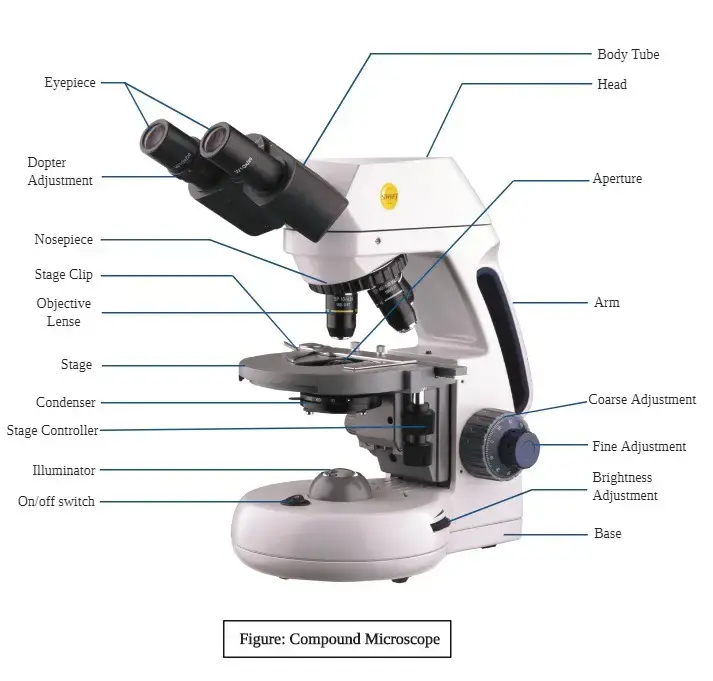
A compound microscope that uses visible light and a system of lenses to magnify specimens. The magnification goes up to 1000x; it is an important tool in microbiology, pathology, molecular biology, and life sciences. Its magnifying power: a function of its combination of an objective and an ocular lens:
m = D/f₀ × L/fₑ
- m = magnifying power
- D = least distance of distinct vision
- L = tube length
- fₑ = focal length of ocular lens
- f₀ = focal length of objective lens
Working Principle
Condenser – focuses the light upon the specimen. This transmitted light is then taken by the objective lens and used to produce a magnified, real image through the body tube. This light is refracted and goes through the ocular lens to produce an even larger secondary image from the primary magnified one. The last image is appears at the nearest point of clear vision.
Parts of a Microscope
- Illuminator (light source): Supplies the light needed to view the specimen.
- Diaphragm (iris): Controls the size and amount of light in the beam.
- Condenser: The purpose of the condenser is to concentrate the light on the object being viewed.
- Condenser Focus Knob: Used to move the condenser in order to focus light.
- Rack Stop – Limits how far upward the stage can move and thus prevents the objectives from breaking the slides.
- Stage: Supports the specimen slide.
- Stage Control Knobs: Move the slide left, right, up, and down.
- Nose Piece: It rotates to change objectives.
- Objective Lens: The objective lens offers the first point of magnification, and there are several objective lenses with varying magnification powers.
- Tube (Head): It holds the ocular and objective lenses, maintaining the optical path.
- Ocular (the eyepiece): It magnifies the intermediate image into the final image.
- Diopter Adjustment: Diopter Adjustment lets the operator adjust the focus for slight variations in vision.
- Adjustment Knobs:
- Fine adjustment knob: adjusts focus on fine details.
- Coarse adjustment knob function: provides movement of stage for primary focus.
- Arm – This part of a microscope supports the body tube and can be used as a handle.
- Base: Gives the microscope support.
- Light switch/light dimmer: Light focus and control.
Applications
- Microbiology – Morphology of Microorganisms.
- Histopathology – study of tissue, cytopathic effects, and tumors.
- Cytology – study of the cell structure.
- Biology – Looking at cells, tissues, and biological parts.
Limitations
- Will not work for anything smaller than the wavelength of visible light (~0.4 μm).
- Even up against sophisticated imaging equipment, the resolution and contrast are limited.
- It is not suitable for seeing inside living cells.
- Specimens must be thin and stained to be visible.
Bright-field Microscope
In bright-field microscopy, it is the specimen which is dark and the background is light. Bright-field microscope: A light microscope that uses visible light and a system of lenses to magnify images of small samples. The light source is under the stage in a bright-field scope, so the sample is illuminated from the bottom. The light that travels through the clear or partially clear specimen is gathered by an objective lens passing it onwards to the eyepiece. This results in a light image against a black background, making it easy to view detail in the sample.
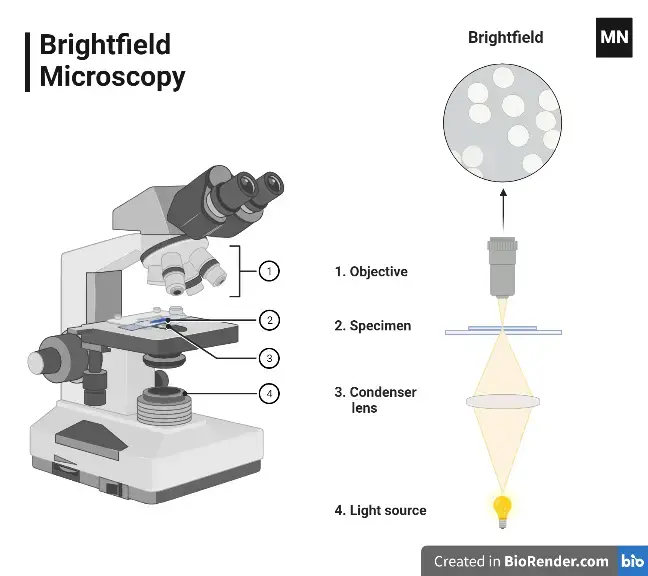
Light microscopes are the standard types of microscopes found everywhere; these bright-field microscopes. They are used frequently to study cells, tissues, and small structures of materials. A benefit of bright-field microscopy is that it is simple and straightforward to operate. Furthermore, it is relatively inexpensive when compared to other types of microscopes.
But bright-field microscopy is limited by many factors, including low distinction for transparent or non-colored specimens, and inability to differentiate things too closely packed together. Overcoming these limitations requires the use of another type of microscopy such as phase contrast microscopy or fluorescence microscopy.
Applications of Bright-field Microscope
- These are used in the laboratory for studying the outer structure of microorganisms.
Advantages
- Widely available: Bright-field microscopes are widely available and are often used in educational settings and laboratories.
- Easy to use: A bright-field microscope is relatively simple to use, even for someone who is not very familiar with these machines.
- Cheap: Bright field microscopes are relatively cheap in comparison to other microscopes.
- Bright-field microscopy is suitable for opaque or semi-transparent samples: Bright-field microscopes are useful for examining opaque or semi-transparent samples, such as cells, tissues, and small features in materials.
Disadvantages:
- Inadequate contrast for transparent or colorless samples: Bright field microscopy may not provide enough contrast for transparent or colorless samples such as bacteria or algae.
- Lack of detail: Bright-field microscopy cannot resolve structures that are close together, so it has a lack of detail.
- Few lighting options: In many cases, bright-field microscopes have a single light source, which may not be adequate for viewing certain samples.
- Limited adjustments: Bright-field microscopes often have limited adjustments, such as the ability to focus or adjust the eyepieces, which may make it more difficult to obtain a clear image.
3. Phase Contrast Microscope
Phase Contrast Microscope is an optical instrument that translates minute phase shifts in light into differences in intensity, thereby producing high-contrast images. These changes take place as light shines through transparent specimens, which the human eye cannot see. Through the use of special optical components, these phase differences can be transformed into changes in brightness, which we can see as differences in the detail.
There is a special microscope, especially for seeing living cells and transparent structures without staining or fixing. Can be viewed in better contrast detail, including subcellular organelles, etc.
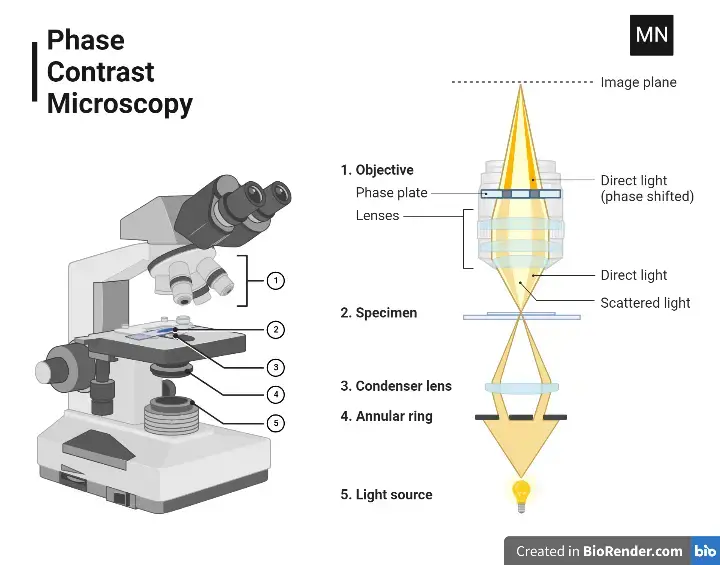
Working Principle
The light from the illuminator passes through a condenser annulus and is then focused onto the specimen. Because of differences in the specimen’s index of refraction and thickness, some light rays are phase retarded more than others. A phase plate placed in the optical pathway converts these phase shifts into amplitude shifts (contrast) in the final image. Regions with a higher index of refraction or greater thickness undergo a larger phase shift, resulting in more significant intensity variations.
Components of a Phase Contrast Microscope.
A phase contrast microscope has all the parts of a compound microscope along with two important optical components: the condenser annulus and the phase plate.
- Condenser Annulus – Also called the phase condenser or sub-stage annular diaphragm. Below it, it directs a hollow cone of light upon the specimen. Built in the form of a black circular plate with a transparent annular groove, so that light can go through the annulus to light up the specimen.
- Phase Plate – Located Over the rear focal plane of the objective lens. Could be split in two areas:
- Conjugate area: Area corresponding to the light which passes through the condenser annulus.
- Complementary Area: This is a complementary area. It has been painted with a light-retarding substance, for example, magnesium fluoride.
- Alters the phase and/or amplitude of light leaving the sample.
- Comes in two types:
- Positive Phase Plate: Has a Thinner Conjugate Area.
- Enhanced Phase Filter: Contains a conjugate zone that is thicker.
Applications
- Viewing unstained living cells of live cells.
- What are these bugs you ask, protozoa, diatoms, plankton, cysts, helminths, larvae, and everything else thought to be a contaminant agent.
- Investigating subcellular structures and dynamics of cells.
- Making tissue sectioning/scanning thin for histological analysis.
- Lithographic patterns, latex particles, glass chunks, and crystals.
Limitations
- Does not work well with thicker specimens because the light gets scattered.
- Common issues like the halo effect and shade-off, which can obscure details.
- Oh well, condenser annulus decreased aperture, thus the resolution decreases.
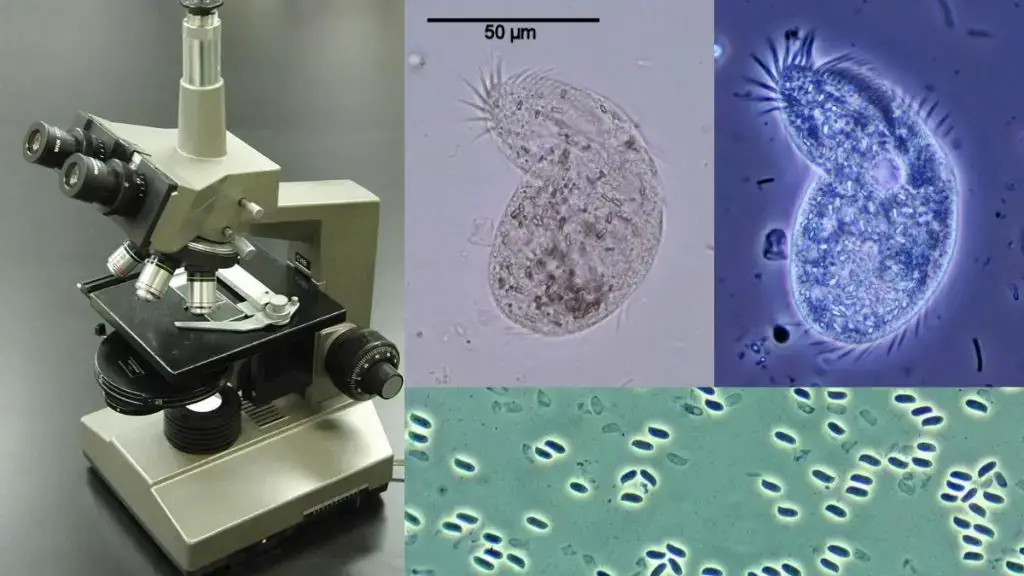
4. Fluorescence Microscopy
Fluorescence microscopy is a type of microscope that uses fluorescence principles to analyze organic and/or inorganic samples. This is especially useful for looking at very distinct parts of cells or tissues that normal light microscopy renders difficult to see.
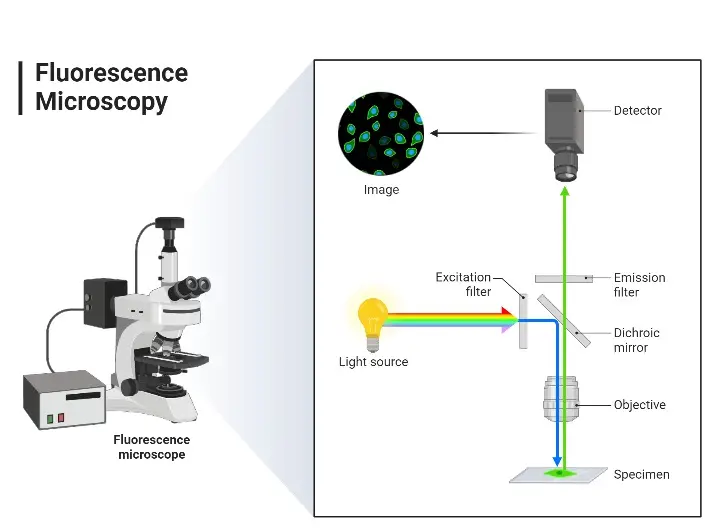
How Fluorescence Microscopy Works
The basic premise of fluorescence microscopy is to (output volume) illuminate fluorescent molecules, termed ‘fluorophores,’ in a specimen. And the procedure can be simplified to a few important steps.
- Sample preparation: Samples are tagged using fluorophores, which are compounds that absorb light of one wavelength and re-emit it at a longer wavelength.
- Light Source: A very bright lamp, like a xenon arc lamp or mercury lamp, provides light to excite fluorophores in the specimen. Such light is usually in the UV or visible range.
- Fluorescent Emission: The fluorophores give off light of longer wavelength (lower energy) after excitation. It is this emitted light that is detected and recorded to make the image.
- Filtering: Specialized filters are used. These filters are selectively used to block all emitted fluorescent light, except for the fluorescence itself, so that only the fluorescence reaches the eye of the observer or the eye of a camera (an automatically recording light-detecting instrument).
Parts of a fluorescence microscope.
A fluorescence microscope has essential additional parts that distinguish it from ordinary optical microscopes.
- Light Source: A strong lamp (e.g., xenon or mercury) that delivers the required excitation light.
- Excitation Filter – this allows certain wavelengths to pass, which must correspond to the absorption spectrum of the fluorochrome in use.
- Dichroic Mirror: Usually placed at a 45-degree angle, this mirror reflects the excitation light toward the specimen and transmits the emission fluorescence light to the detector.
- Emission Filter: This filter allows only certain wavelengths of emitted light to get to the eye, thereby improving the image displayed by blocking out unwanted wavelengths.
Types of Fluorescence Microscope
Fluorescence microscopy is a specialized field of optical microscopy that includes several different types for specific uses in research and diagnostics. This differentiates the major categories of fluorescence microscopes and their traits:
- Epifluorescence Microscope: A very common type of florescence microscope is the epifluorescence. The key to its property is that the excitation light path is the same as the emission light path- both go through the same objective.
- Confocal Microscope: Also known as a confocal laser scanning microscope, uses a spatial pinhole to obstruct out-of-focus light, resulting in 3-D images with improved resolution and contrast. The microscope illuminates a spot on the focal plane with excitation light, which is then optically moved to scan the whole sample.
- Process: Laser illuminates the specimen that is stained with the fluorophore. The resulting emitted fluorescent light travels through a pinhole which allows the light from the focus yet effectively eliminating the background light. That light is then converted into an electrical signal by a photomultiplier tube, and computer software interprets this signal and produces a 3-D image.
- Applications:
- Detection of corneal disease and presence of fungal elements from corneal scrapings? Detection of corneal disease and presence of fungal elements from corneal scrapings?
- Pharmaceutical quality control analysis.
- Optical 3D scanning and imaging.
- Limitations:
- Limited excitation wavelength and narrow bands.
- High cost of the system.
- Multiphoton Microscope: This type of microscope uses 2 or more photons to excite the fluorophore molecules, producing high-res 3D images. The most common types are two-photon and three-photon excitation microscopy.
- Total internal reflection fluorescence (TIRF) microscope – The TIRF Microscope provides a very good image of fluorophore molecules in an aqueous medium near the surface of a high refractive index solid. This type of selective imaging produces images of exceedingly high clarity.
- Pros: The TIRF microscope provides high-contrast, low-background, highly defined images, which is really useful for these particular imaging games.
Applications of Fluorescence Microscopy
Fluorescence microscopy, due to its ability to produce high-contrast, highly specific images, is an essential and prevalent tool in numerous scientific disciplines. Some of the more prominent applications are:
- Cell Biology: Studying cellular structures and processes by labeling specific proteins or organelles with fluorescent dyes.
- Microbiology: Capturing images of microorganisms in order to identify the species and determine their activities in the presence of certain conditions.
- Biomedical research; studying the mechanisms of diseases by seeing how cells interact and how they change over time.
- Environmental Science: Science mineral and biological sample analysis lab.
Advantages
- High sensitivity: Able to detect relatively low concentrations of fluorophores.
- Specificity: The ability to target specific molecules in complex samples by using custom fluorophores.
- Fast Imaging: It allows simultaneous viewing of many fluorescent markers and hence fast analysis.
Limitations
- Photobleaching: Fluorophores will bleach after prolonged exposure to intense light.
- Depth penetration is the restricted capacity to visualize deeper tissues owing to the scattering and absorption of light.
- Elaborate sample prep: Must pay close attention to sample labels and deal with the samples, which is usually tedious.
5. Dark-Field Microscope
One is the dark-field microscope, which is a modified light microscope, differing somewhat in illumination and the image. Below we explore the workings and uses of that sophisticated optical device.
Basic Design and Principle: The Dark-Field microscope utilizes a modified light source. At the heart of this system lies an opaque disk located under the condenser lens. This disc blocks the direct light from the source from entering the objective. Only the light on the specimen is detected. This means that the specimen is being lit laterally, from the side, at a low angle. The scattered light is gathered by the objective lens and then focused on the eyepiece to form an image in which the specimen appears bright against a dark background.
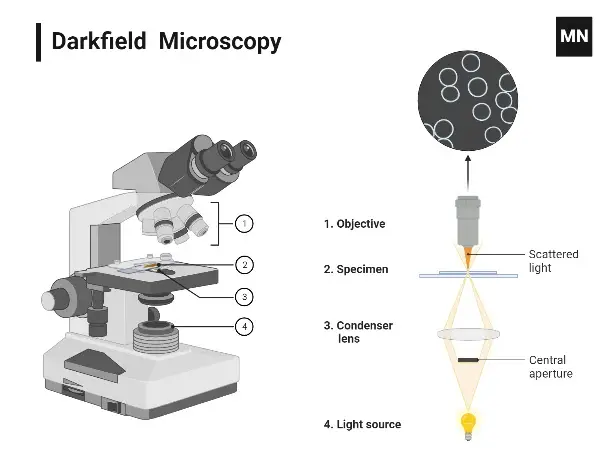
Imaging Characteristics:
- Enhanced contrast and resolution: The dark-field microscope reveals my images in increased contrast and resolution than bright-field microscopy. This is especially good for seeing small things in specimens.
- Dark-Field Microscopy – Viewing Unstained Specimens: One of the greatest benefits of using dark-field microscopy is not having to stain the specimen. This helps you to view objects in their own natural form and texture.
- The resulting images are bright specimens on a dark background.
Dark Field Microscope Uses
- Microbiology:
- Microbial Movement. The darkfield is good for something though; it makes it easier to see the movements of the little creatures. Their mobility fascinates me.
- Spirochetes and thin bacteria: The method is particularly good at viewing very thin bacteria such as spirochetes, which are not easily seen using conventional microscopy.
- Capsulated organisms: Organisms with capsules, or protective layers, around their cell walls. Dark-field microscopy would show the best results in obtaining details of organisms.
- Cytology: Dark field microscopy is used in cytology, the study of cells. It is especially great when you want to look at the inside organelles and really get into what the cell is made up of and what it does.
- Technological Uses: As far as technology goes, the dark-field microscopes have even been configured into computer mice. This makes the mouse perfectly usable on clear surfaces, thus increasing its flexibility and its overall applicability.
- Characterization of Nanoparticles: However, when combined with hyperspectral imaging, dark-field microscopes are a powerful tool for nanoparticle characterization.

Advantages of Dark-Field Microscope
- The image has high contrast because this dark-field contrast can potentially show class fine details and structures that are not seen in bright-field microscopy.
- Dark-field microscopy is especially suitable for transparent or semi-transparent samples, such as bacteria, algae, and small crystals.
- It is able to see fine details and structures: Dark-field is capable of observing fine details and structures that are lost in bright-field, such as flagella and bacterial cells, or algal spines.
Disadvantages of Dark-Field Microscope
- Reduced field of view: The field of view in dark-field is typically smaller than that in bright-field.
- Cannot give a true color image: dark-field microscopy cannot give a true color image of the sample.
- Needs experienced operator: Dark-field microscopy necessitates a very experienced operator to align the dark field microscope and illuminate the light source for it.
- Few lighting choices: Often, dark-field microscopes only have one light, and some samples or areas just seem too dark.
- Limited adjustments: Dark-field microscopes often have limited adjustments, such as the ability to focus or adjust the eyepieces, which may make it more difficult to obtain a clear image.
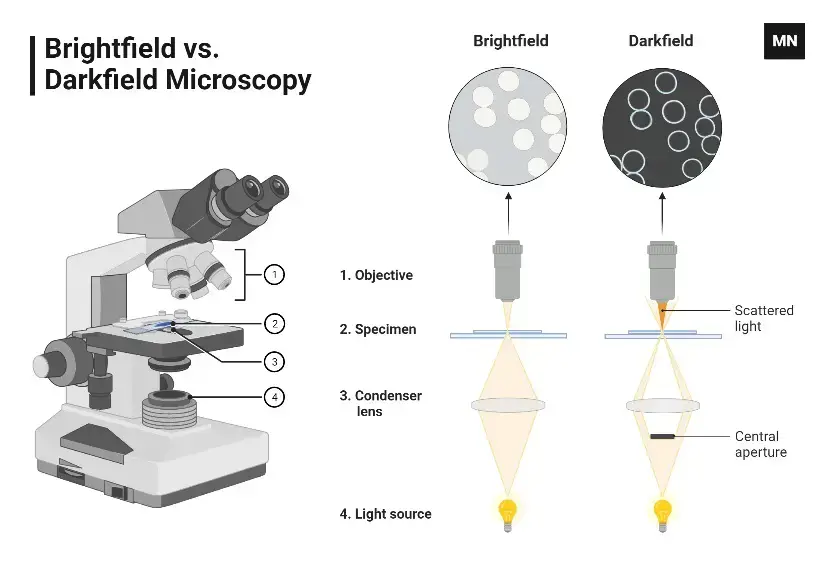
6. Electron Microscope
The Electron Microscope is a new form of microscope in which it uses accelerated electron beams as illumination instead of ordinary light rays like the opt, microscope. The following characteristics are the foundation upon which both the structure and operation of this instrument are based:
- Electromagnetic Lenses: The Electron Microscopes employ electromagnets in lieu of glass lenses. These electromagnetic lenses serve the purpose of focusing and steering accelerated beams of electrons to provide accurate and clear imaging.
- High-Resolution Imaging: One of the most significant benefits of the Electron Microscope is its capacity to capture images with incredibly high resolution. This is due to the naturally short wavelength of electrons that allow the observation of minute details not visible with optical microscopes.
- Magnification Capabilities: The Electron Microscope can magnify specimens up to 10,000,000X. They possess the ability to magnify up to the nanoscale, showing things that have never been seen before by scientists.
- Contrast and Detail: Apart from its resolution and magnification qualities, the Electron Microscope is very well known for its high contrast images. That guarantees that even the smallest of changes in specimen composition and structure are clearly visualized, giving researchers a full report of their samples.
- Specimen Clarity: Its sophistication and technology allow specimens as small as 0.2 nm to be seen clearly. This ability is essential for experiments that require probing nanostructures and features.
Principle of Electron Microscope
Working on a different principle from that of the typical light microscope, the Electron Microscope is a state-of-the-art microscope. The basic idea and the working principle of the Electron Microscope are explained as follows:
- Electron Generation: The electron gun, usually a heated tungsten filament or a field emission source, is the heart of the electron microscope. This part of the image creates a beam of electrons that are accelerated by using high voltage, the voltage is usually in the range of 100 kV up to 1000 kV.
- Electron Acceleration and Focusing: Inside the microscope’s vacuum system, an anode plate accelerates the electrons. After this acceleration, the electron beam is precisely focused on the sample. This focusing is done through the use of multiple apertures and electromagnetic lenses to maintain accuracy in the electron trajectory.
- Electron-Specimen Interaction: The accelerated electron beam strikes the sample, interacting with its constituents. This interaction causes electrons to scatter. Most importantly, this level of scattering depends on the specimen’s refractive index, thickness, etc. Regions or parts of the specimen deflect electrons to differing extents, giving rise to contrast in the final image.
- Image Formation: Scattered electrons from the specimen are then captured and sent through several electromagnetic lenses, specifically objective and ocular. Both of these types of lenses are critical in bringing scattered electron beams into focus. These scattered beams are then picked up by magnetic lenses which convert them into greatly enlarged images. The naturally short wavelength of the electrons guarantees that these images show the very fine details of the sample.
Electron Microscope Parts
A highly advanced electron microscope, its components and structure guarantee optimal operational abilities. Below is a more detailed description of the main parts found in a common electron microscope.
- The electron gun (electron source).
- The electron gun is responsible for producing the electron beams necessary for illuminating the specimen.
- It consists of a cathode (usually a tungsten filament) and an anode. When the tungsten filament in a vacuum is heated using high voltage, it gives off electrons. A negative circular cap surrounding these electrons acts to constrain the electrons into a small electron beam, and this beam is then accelerated by the positive anode to encounter the sample.
- Electromagnetic Lenses:
- Unlike optical microscopes that use glass lenses, electron microscopes depend on electromagnetic lenses, which use magnetic fields generated by electromagnets to focus and steer electron beams.
- Types:
- Condenser Lens: Focuses the accelerated electron beam onto the specimen, ensuring a precise and concentrated beam.
- Objective Lens: Objective lens collects electron beams after they emerge from the specimen and magnifies it.
- Projector (Ocular) Lens: magnifies the image formed by the objective lenses.
- Aperture System:
- These tiny holes filter out stray electrons from the electron beam, both before and after the beam strikes the specimen.
- The system consists of thin disks with tiny pores from 2 to 100 μm. Important apertures are the condenser aperture (below condenser lens) and the objective aperture (between the objective and projector lenses).
- Sample Holder:
- The purpose of this device is a solid base with a mechanical arm to hold specimens in place.
- Composition: It is usually an extremely thin carbon film mounted on a metal grid.
- Vacuum System:
- The vacuum creates an environment without air, allowing the easy creation of electrons and their free movement.
- The lenses, aperture, sample holder, and specimens are kept in the vacuum column. To sustain such a vacuum difference, high-efficiency vacuum pumps are employed to avoid collision and scatter of electrons.
- Imaging System:
- The function of this machine is to digitize, enlarge, and display the images.
- It consists of electromagnetic lenses, a phosphorescent screen for viewing the image, and a camera to capture and display the image. The resulting image, called an electron micrograph, is either projected onto a phosphorescent viewing plate or a television screen.
Application of Electron Microscope
- Microbiology: Electron microscopes have a crucial function in microbiological research in that they allow scientists to see the ultra-structures of microbes. They are invaluable for deciphering the structural details of viruses, bacterial cells, flagella, and pili, to name a few, and consequently extending our knowledge of microbial physiology and pathogenesis.
- Crystallography and Nanotechnology: In terms of crystallography, electron microscopy is employed to examine crystals in order to deduct the atomic configurations and lattice defects in the crystal structure. Moreover, since nanotechnology attempts to manipulate matter on the atomic or molecular level, electron microscopy gives them the picture so that they would be able to perform this precision surgery.
- Cellular Biology: The shape of cell organelles such as mitochondria or the Golgi apparatus can be examined in detail with electron microscopes. This has been instrumental in the analysis of cellular function and malfunction.
- Forensic Science: Forensics uses electron microscopy for ballistic analysis of gunshots. By studying gunshot residues and bullet fragments, investigators can obtain important evidence about weapons fired in criminal acts.
- Geology: Geologists use electron microscopes to look at the microstructure of rocks, minerals, and gemstones. It helps understand how they were formed, what their past was, and how they have changed over the years.
- Research and quality control in industry. In industry, electron microscopy is crucial, often as a quality control measure. It helps detect cracks, holes, and other kinds of flaws within materials. (Also in the pharmaceutical field, it assists in producing drugs since it allows researchers to observe the interactions of drugs with the molecular world and the analysis of atomic structures.)
Limitations of Electron Microscope
Electron microscopy is a powerful revolutionary imaging tool for scientists but it has its flaws. Those limitations come with the territory of the technology and they can be frustrating to the researcher and prevent them from using it in some situations. These are some of the major drawbacks of electron microscopy:
- Economics and other possible complexities – The biggest problem with electron microscopes is that they are very expensive. It costs a lot of money to get these instruments and maintain them and use them. Because the system is so complex, people must be specially trained on how to use it. This creates even more expenses, and still further limits those who may benefit.
- Monochromatic Imaging: Electron microscope images are in black and white. This lack of color can at times reduce the information available from the images, particularly when it is used to distinguish different parts or structures of a specimen.
- TEM specimen thickness limitations. Transmission electron microscopy (TEM) requires very thin specimens, usually only a few nanometers thick. Specimens of such thickness are difficult to prepare and may be impossible for some samples. Additionally, this makes it impossible to get some information, such as that which could be obtained from thicker specimens.
- Vacuum Requirement: Electron microscopes work in a vacuum so that the constant stream of electrons is not disturbed by air molecules. This uses an advanced vacuum system, which can be bulky (can = increased complexity. Moreover, the need for vacuum precludes the observation of living specimens and those that exist with water, possibly disturbing their native structures.
Types of Electron Microscope
Different kinds of electron microscopes exist today, such as:
1. Scanning Electron Microscope (SEM)
SEM stands for Scanning Electron Microscope. It is a type of electron microscope that has a different scheme to acquiring images and capabilities. This tool is very comprehensive in that it examines the surface of specimens and gives amazing three-dimensional images with a wealth of details. The basic description of the SEM, its structure, and characteristics are described below:
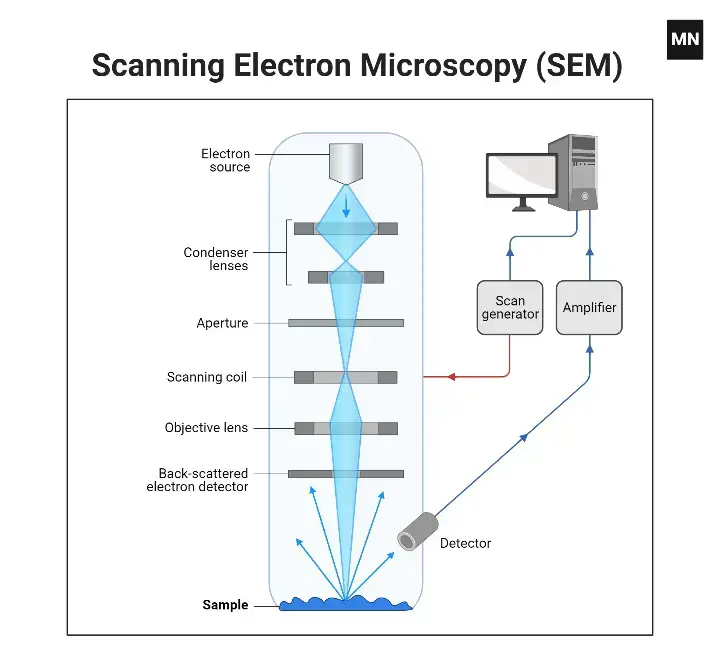
- Operational Mechanism:
- The Scanning Electron Microscope (SEM) works by scanning a sample with a high-energy beam of electrons. Using this scanning pattern, it maps the surface of the specimen.
- In contrast to the TEM (Transmission Electron Microscope), where the incident electron beam passes through the sample, in the SEM, the incident beam interacts with the specimen, resulting in electrons that are emitted, backscattered, or diffracted from the surface of the sample.
- Image Formation:
- The resulting images produced by the SEM (Scanning Electron Microscope) are 3-D and provide a topographical scan of the sample’s surface. These photographs graphically illustrate the morphological characteristics and the texture of the sample.
- Though the SEM doesn’t give the magnification of the TEM, it has high resolution with better images. The result is clear, detailed images with a depth perspective that gives a true feel of what surface structures are like.
- Detectors in SEM:
- Central to the scanning electron microscope are its detectors, which detect different types of electrons providing more information and detail to the actual picture.
- Backscattered electron detectors: detect electrons that have been backscattered by the specimen. Such electrons are generally a function of the atomic number of the sample and thus contain information about its composition.
- Secondary Electron Detectors: These are sensitive to secondary electrons from the surface of the specimen energized by the incident electron beam. These electrons furnish insights into the specimen’s topography.
- X-rays Detectors: These detectors measure levels of X-ray released from the specimen to determine elemental composition.
- Central to the scanning electron microscope are its detectors, which detect different types of electrons providing more information and detail to the actual picture.
- Application of Scanning Electron Microscope (SEM) – Used to study microorganisms’ surface areas in great detail.
2. Transmission Electron Microscope (TEM)
The transmission electron microscope (TEM) constitutes a specific type of electron microscope. Don’t get me wrong, it doesn’t work and take pictures in the same way, but it gives researchers the chance to look into the nanoscopic world like never before. The basic principle and characteristic of the TEM are thus clarified in the following:
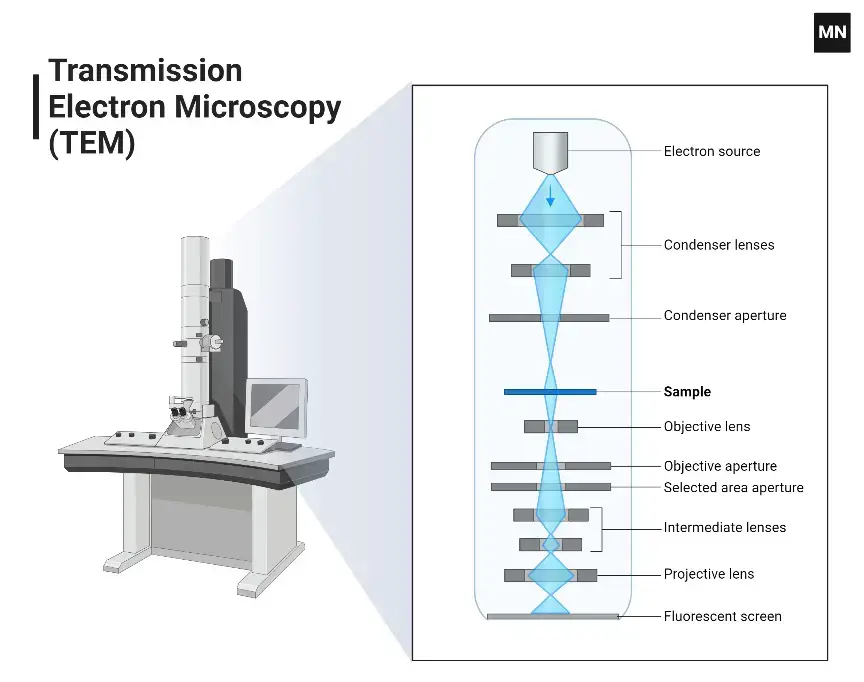
- Principle of Operation: The TEM works by creating an enlarged image of a sample through the use of transmitted electrons. This is due to the passage of the electron beam interacting with the components of the specimen.
- Specimen Thickness:
- An absolutely fundamental characteristic of Transmission Electron Microscopy (TEM) imaging is that one needs to have very thin specimens. Such specimens generally are much less than 100 nm thick. To give you an idea, they are about 200 times thinner than those used in traditional compound microscopes.
- Electron Interaction and Image Formation:
- The combination of electron beam, focused onto the specimen by a condenser lens, interacts with parts of the specimen. After that, electrons are ejected from the sample. These electrons are then passed through a series of EM lenses, both objective and ocular lenses.
- When these electrons strike the fluorescent screen, they cause the screen to fluoresce and form an enlarged image. This image production is the result of electron interaction with the screen, in which electrons strike and excite the screen to cause it to fluoresce, thus producing the image of the specimen.
- Image Characteristics:
- The TEM is well known for its two-dimensional images. They are black and white images but extremely high quality even though they are a single color. By their very nature, TEM images are of extremely high resolution, and indeed, this facility to visualize details on a molecular or atomic scale affirms this notion.
- The TEM has a wide range of magnification from as low as 2X to 50,000X. This large range of magnification guarantees that scientists can adjust the imaging scale to fit their needs.
- This is very common in scientific research: Of all electron electron microscopes, the TEM is by far the most common. It is commonly used in scientific research because it reveals small structures that cannot be resolved by optical microscopes.
- Use of transmission electron microscope (TEM) – It is used to view the specimen’s internal structure.
3. Confocal Microscopy
Confocal microscopy, which is also called confocal laser scanning microscopy (CLSM) or laser confocal scanning microscopy (LCSM), stands as a revolutionary development in the field of optical microscopy.
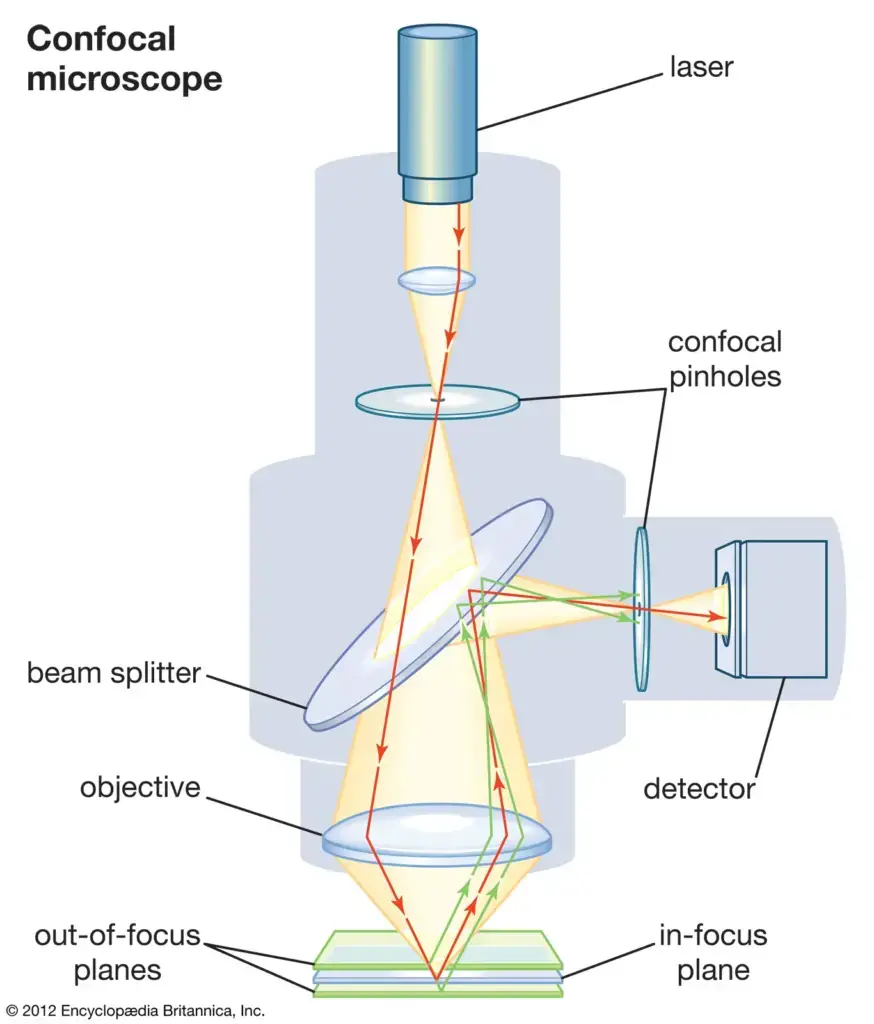
- Principle of Operation: Central to the functionality of confocal microscopy is the strategic use of a spatial pinhole. This pinhole is located at the focal plane and serves to block out-of-focus light in order to enhance the optical resolution of the obtained micrograph, as well as improve the contrast of the micrograph. Only in-focus light reaches the detector, which allows a sharply defined plane in the specimen to be scanned.
- Three-Dimensional Imaging: Confocal microscopy offers many advantages, one of which is optical sectioning. The microscope allows you to take a series of two-dimensional images at different depths through the specimen in sequence, and then reconstruct the three-dimensional architecture that constitutes the internal structure of the sample. This is a great tool for learning about spatial relationships and the complex structures found in biological specimens, etc.
- Advantages: The inherent characteristics of confocal microscopy’s architecture and manner of functioning make it preferable to conventional optical microscopy in several ways. In particular, improved resolution and contrast even result in three-dimensional images, and thus it is often used for larger objects such as cells and even organelles.
- Application – Confocal microscopy is widely used in scientific and industrial circles, and common applications include life sciences, semiconductor review, and materials science.
There are different types of electron microscopes.
Boasting better resolution than any other form of microscopy, electron microscopy has since been derived into its own line of specialized microscopy. There are several electron microscopes other than the basics such as the TEM (Transmission Electron Microscope) that I was familiar with and the SEM (Scanning Electron Microscope) which introduce their own functions:
- REM (reflective electron microscope) – Reflection Electron Microscopes use electrons that are reflected from or scattered from the surface of the specimen to form an image. This microscope employs various techniques such as diffraction, imaging, and spectroscopy.
- STEM (Scanning Transmission Electron Microscope): The STEM is a combination microscope that uses both SEM and TEM technology. With these two types of microscopes utilized together, such as in STEM (Scanning Tunneling Electron Microscopy), almost any type of image can be produced, and surface and internal structures of a specimen can both be examined.
- Scanning Tunneling Microscope (STM): The scanning tunneling microscope (STM) is the first technique developed that can image and manipulate individual atoms. Unlike other electron microscopes, the STM depends on the quantum mechanical effect of electron tunneling. The STM does not bore into the specimen; rather, it scans across the atoms and molecules on the specimen’s surface. The images generated are three-dimensional of these surface atoms and molecules. The STM, with its capability to image atomic-scale surface details, has become the biggest breakthrough for surface science with the visualization of atomic arrangements and molecular architecture.
7. Polarizing microscopes
A polarized light microscope is a specialized type of conventional light microscope that employs polarized light to illuminate the sample. Unlike conventional optical microscopes that utilize natural light, the polarizing microscope utilizes polarized light, which is light in which the vibrations of the light waves are sheared into a single plane.
In other words, the main benefit of using polarized light is that it greatly improves the quality and contrast of the image. This improvement is especially useful for viewing samples that have a natural birefringent nature. The polarized light then passes through the sample interacting with these properties, resulting in unique and refined imagery.
Polarizing microscopes, also known as petrographic microscopes, are very useful in geology and mineralogy. They are such useful tools for petrologists, allowing them to distinguish between the different minerals in thin sections of rocks.
Polarizing Microscope Principle
The basic principle of the polarizing microscope is the control of the beams of light that allow information from anisotropic objects to come through. Let me break it down for you:
- Light source and polarization – The microscope begins by emitting standard light from its illuminator. This light is passed through a polarizer that converts it into plane-polarized light. Now the light waves oscillate mainly in one plane.
- Interaction with the Specimen: The plane-polarized light is then passed into an anisotropic specimen. Anisotropic things have more than one refractive index, so they affect light in a special way.
- Birefringence: When the plane-polarized light hits the anisotropic crystal, an occurrence referred to as birefringence takes place. This in turn leads to the separation of the light wave into an ordinary wave and an extraordinary wave. These waves are orthogonal, that is, they move in a manner that is perpendicular to each other.
- Phase Transmission and Analysis: The two waves transmitted through the specimen are now shifted in phase because they have been retarded by differing amounts. Are then intercepted by an analyzer, a device very important in the polarizing microscope. The part of the analyzer is to merge these waves back together so that they can pass through the lens of the eye.
- Image Formation: The end result of this process is a magnified, high-resolution image. The properties of the image are determined by how the specimen alters the polarized light, thereby allowing one to see things that would not be visible in normal light microscopy.
Polarizing Microscope Parts
The polarizing microscope is very similar to the normal light microscope, except that it has special adaptations used for polarized light microscopy. These parts are essential to the microscope’s ability to illuminate complexities of specimens. So here’s a closer look at these sections:
- Polarizer: Located between the illuminator and the specimen stage, the polarizer is a key. It is a filter that makes light coming out of the light source which is unpolarized into plane-polarized light. This way, the light passing through the specimen vibrates mostly in only one plane.
- Analyzer: Located in the light path above the objective lenses, the analyzer is the other key polarizing filter. Its main purpose is to rejoin the light waves once they have passed over the specimen. This recombination is essential to produce the final image that is seen.
- Accessory Plates: Accessory plates, also known as compensators and retardation plates, are inserted before the analyzer in the optical path. They exist to measure the optical path difference or the relative retardation between the ordinary and extraordinary waves, caused by birefringence. They increase the contrast of the images so you can see inside the specimen better.
- Specialized Stage: Unlike the fixed stages found in many standard microscopes, this microscope has a circular stage. This stage can spin 360°. This type of design also permits the very accurate alignment of the specimen to some special orientations required in a few polarized light microscopy methods.
Uses of Polarizing Microscope
The polarizing microscope has the special property of allowing polarized light to illuminate the specimen. This has applications in many different scientific areas. These are the main functions of this particular kind of microscope:
- Of course, one of the main uses of the polarizing microscope is geological studies. This microscope is used by geologists to carefully observe and document different geological samples. The accurate study of the rocks, minerals, and everything that makes up soil. By the polarizing microscope, the crystal forms, mineral content, etc., appearing in these thin sections are revealed.
- In addition to geology, the polarizing microscope has valuable applications in biology. Especially for a clear biological object. It helps in the analysis of planktons, diatoms, protozoans, etc., for example. When using polarized light, the internal structures of these organisms, which may be hidden by ordinary microscopic imaging, are brought to life.
Limitations of Polarizing Microscope
Though it has unique advantages in some scientific fields, the polarizing microscope is not total perfection. Such limitations are a result of its nature and its functional mechanism and are as follows:
- The polarizing microscope has a major drawback in that it requires an anisotropic specimen. If the crystal is anisotropic, it will not have the same properties in all directions, which is what the microscope needs for the desired birefringent effect. Therefore, isotropic materials, which have the same properties in all directions, cannot be observed through a polarizing microscope. This limitation constrains the spectrum of samples that can be usefully examined by this method.
- It has its drawbacks, though, such as the restriction of its use like the polarizing scope is a little too specialized. It is excellent for geology and some biology studies, but overall, it doesn’t seem to be a good tool of science. Its main utility is to those places where birefringence or the properties of anisotropic materials are of utmost concern.
8. Scanning Probe Microscope
SPMs create images with nanometer resolution that allows many properties of little structures and surfaces to be investigated. There are many different kinds of SPMs. For instance, there are Atomic Force Microscopes (AFMs), Scanning Tunneling Microscopes (STMs), and Scanning Near-Field Optical Microscopes (SNOMs). These devices operate by employing a probe that interacts in several methods with a sample: a probe that physically touches a sample and measures the force between them, a probe that is close enough for electrons to tunnel through the gap to the sample, and a probe that determines the near-field optical properties of a sample.
The use of SPMs helps in analyzing the surface properties of samples in several disciplines, such as materials science, biology, and nanotechnology, and aids in the examination of the composition and structure of these relatively small structures. (The sentence is not well written). They also are used to fabricate and manipulate small structures, for instance nanowires and nanotubes, and to characterize the properties of individual atoms and molecules.
The principle of the Scanning Probe Microscope.
In a scanning probe microscope, the probe tip is mounted on the end of a cantilever. The tip is so pointy that it is able to scan every single atom, moving exactly and exactly over the surface of the sample. Its tip is placed very near the surface of the sample, which gives rise to forces deflecting the cantilever. The laser measures how far in distance the deflection is. And after scanning, the end picture ends up on a computer.
Scanning probe microscope types.
Some of the various types of SPM (scanning probe microscope) use. Some of the SPM types include:
- Atomic Force Microscopes (AFMs): AFMs utilize a sharp, cantilevered probe to measure the forces between the probe and the sample as the probe is scanned across the surface. The probe is usually a very hard and stiffer material (like silicon) mounted on a piezoelectric element that shifts the probe in very small intervals. Atomic force microscopy can be used not only to measure the topography of a sample but also to measure electrical, mechanical, and magnetic characteristics.
- Scanning Tunneling Microscopes (STMs): Tunneling current is measured between the probe and sample as the very sharp probe is scanned across the surface. The probe is usually some metallic object, like tungsten, for instance, mounted on some sort of piezoelectric element that moves the probe in very nice small increments. Especially in the sense of measuring the topography of a sample and investigating the electronic properties of surfaces.
- Scanning near-field optical microscopes (SNOMs): SNOMs scan a metal tip (such as gold) across a sample and analyze the optical near-field properties of the sample. The probe is usually attached to a piezoelectric element that steps the probe very small paces. What can be used to examine various samples’ absorption or scattering of light in SNOMs?
- Scanning Capacitance Microscopes (SCMs): SCMs use a probe with a sharp tip to measure the capacitance between the probe and the sample as the probe is scanned across the surface. The probe is usually some metal glued to a piece of piezoelectric material that steps the probe in extremely small amounts. SCMs can measure the sample topography as well as electric properties.
- Kelvin probe force microscopy (SKPMs): SKPMs utilize a probe with a sharp tip to measure the electrostatic potential of a sample when the probe is scanned over the surface. The probe is usually metal and is attached to a piezoelectric crystal that cause the probe to move in small steps. The KPFM can look at the topography of a sample as well as its electrical nature.
Application of SPM
- To test different aspects of a sample, such as its electrical properties.
- This microscope is used to analyze the magnetic property of the specimen.
- Using this microscope, it is possible to transfer sample information.
9. Dissecting microscope (stereo microscope)
The Dissecting Microscope, otherwise known as the Stereo Microscope, is a special type of light microscope. The dissecting light microscope uses the principle of REFLECTED light microscopy, in contrast to traditional microscopes which use transmitted light through specimens.
Instead, the central operating principle of the dissecting microscope involves the reflection of light from the surface of the specimen. The reflected light is collected by the microscope’s optics and forms a magnified image.
The design and optics of the dissecting microscope are such that they allow the specimen to be seen in three dimensions. Unlike most other light microscopes, which are used for viewing thin two-dimensional objects mounted on slides.
The dissecting microscope, as its name implies, is a great device for dissecting biology specimens. It gives researchers and students an accurate, larger-than-life view of their specimen, so they can work better.
Apart from dissections, the 3D objects that the stereo microscope allows us to see make it an all-purpose instrument so that people can use it for something like taking samples of minerals in geology or in technology to examine something like electronics.
Principle of Stereo Microscope
A dissecting microscope, or stereo microscope, works based on a different optical principle from that of a compound microscope. By its very nature, the stereo microscope is built to give a 3D view of the object being observed.
- Optical Principle: The basic concept behind the stereo microscope is its two separate optical paths. The difference being that in a typical microscope there is only one pathway of light, and in a stereoscope there are two, one for each ocular lens. This is the splitting of the path of light, which allows for a stereoscopic or three-dimensional image to be created. OK, the two eyes each focus on the specimen from a slightly different angle and each receive two slightly different images. When viewed together, these converge and create depth perception, which enables visualization of the 3-D structure of the specimen.
- Illumination System: It is a stereo microscope that has an incident (reflecting) light and transmitted light (or a condenser). The upper light, known as incident light, shines on the surface of the specimen and is especially beneficial when dissecting or working with opaque specimens. On the other hand, the light from the bottom or transmitted light passes through the specimen making it easier to see clear or semi-clear specimens.
- Objective Lenses, Stage. The stereo microscope’s objectives are enclosed in a cylindrical cone, rather than having exposed objectives like a compound microscope. It shields the lenses and also accommodates the microscope’s unusual optical arrangement. With the variety of specimens to be examined, the stage of the stereo microscope tends to be bigger than that of a compound microscope. One thing that is interesting is the groove or means of holding the specimen in place while viewing.
Applications of Stereo Microscope
- Biological Procedures:
- Dissection and microsurgery: The stereomicroscope is highly useful in biological laboratories during dissection. The capability to produce a three-dimensional perspective permits detailed exploration and manipulation of small organism samples, tissues, and organs. It is also used in microsurgery, where precision and depth perception are crucial.
- Archaeology and Geology Study: The microscope is commonly used in archaeology and geology. Archaeologists use it to inspect and check artifacts so that nothing, no matter how small, escapes notice. Likewise, geologists use the stereo microscope to view rock samples, minerals, and other geological specimens, determining information about their composition, structure, and history.
- Electronics and Precision Engineering:
- Nano electric appliance manufacturing and welding or repair: With the complexity of electronics today from microchips to circuit boards, tools are needed that provide precision and revealing capabilities. The use of stereo microscopes is essential for the manufacture, inspection, and repair of such a component. Its capability to be magnified and seen in 3D guarantees that the smallest of parts get placed, soldered, or repaired correctly.
- Watch Making: The horological world of watchmaking demands close attention and a delicate wrist. The stereo microscope helps watchmakers put together the small parts of the action of a watch, making the watch work accurately and dependably.
- Mobile Phone Repair – With today’s cell phones becoming more technologically advanced, to repair any problem, you need a tool that is going to vividly display the fine workings of their innards. I envisioned the stereo microscope as a means to observe and mend the tiniest aspects of cell phones: circuitry, perhaps connectors.
Limitations of Dissecting Microscope or Stereo Microscope
Dissecting microscopes or stereo microscopes have many disadvantages.
- Limited Applicability: Now, the stereo microscope is essential in that it can only be used for very specific things that need the person to see depth or something with three dimensions. Not the instrument of choice for higher magnification and the examination of cellular and subcellular structures.
- Magnification Constraints: One of the main limitations of the stereo microscope is that it does not have very good magnification power. The magnification for a stereo microscope is not as great as that of a compound microscope or an electron microscope, as the stereo microscope cannot magnify a specimen as much as the other types. That limitation precludes, however, use of the method in examining ultra-subtle detail, structure on the cellular or molecular level.
- Economic Considerations: Stereo microscopes, particularly high-magnification ones with various capabilities, can be costly investments.
10. Inverted Microscopes
As its name implies, the Inverted Microscope is an ‘upside down’ adaptation from a typical light microscope, with inverted positions of its primary features. Such a type of specialized microscope can serve better for some observations than others.
- Design and Configuration: The main difference of the inverted microscope mainly has to do with that configuration. An inverted microscope basically turns the traditional upright microscope upside down; in a traditional microscope, your light source and condenser are below the specimen and your objective lenses are above. The objective lenses and turret are located below the stage and the illuminator and condenser are at the top of it. This in turn requires that viewers look up at the image to imagine the specimen.
- Operational Principle: the Inverted Microscope basically functions the same way as an upright microscope. What it does is exploit the behavior of light to enlarge and clarify the details of samples. Yet the inverted design serves some special observational situations, especially in use with larger containers in which a sample is to be inspected and culture dishes in the examination of living cells.
- Instrumentation: The primary elements of the inverted microscope are the same as in normal microscopes; however, the configuration is a defining factor of this type of microscope. It is inverted, so the light source, which is usually at the bottom in standard microscopes, is at the top in the inverted one. On the other hand, the Inverted Microscope has a turret and objective lenses, typically found above the stage in upright microscopes, that are positioned under the stage. Enabling a direct approach to the specimen, especially for large or unusual containers.
- Digital Enhancements: So many of today’s Inverted Microscopes are accompanied by a digital camera to assist them by technology. These cameras allow them to take very nice pictures or movies of their specimens for analysis, documentation, and later distribution of the results.
Uses of Inverted Microscope
- Metallurgical – In the field of metallurgy, the Inverted Microscope is an essential piece of equipment. It is used to examine the microscopic structure of metals and minerals. When these samples are lit from the top as the researchers look at them from below, they can help determine the grain structure, phase distribution, and other microstructural characteristics of metal samples. It plays a central role in the study of its properties and performance, enabling the creation of new alloys and enhancing the ones present.
- Cytological Studies – The study of cells, known as cytology, also relies on the advantages of the inverted microscope. This tool is used by researchers to watch the cells divide, watching the steps of mitosis/meiosis as they are occurring on the cellular level. This type of microscope is specifically good for observation of cultures in Petri dishes because the specimen is unrestricted from above.
- Microbiological Investigations: the inverted microscope comes in handy with certain organisms. For example, it is used to detect M. Tuberculosis, the organism that causes tuberculosis. Moreover, it allows for the possibility of seeing what certain pathogens like Phytophthora spp. look like when grown in culture. The Inverted Microscope provides a clear glimpse of these microorganisms to describe their morphology, life cycle, and interaction within their environment.
Limitations of Inverted Microscope
- Limited Availability and High Cost: Even more, the knowledge of how an inverted microscope is constrained by the disadvantage that it is not available in many research facilities and even if it is, the disadvantage that its cost is.sky-high. The Inverted Microscope isn’t something you would likely find in laboratories because standard upright microscopes are much more common. Additionally, the Inverted Microscope’s custom functionality and applications typically cost significantly more, which can be a major expense for most institutions. This expense is something that can hold back some research laboratories, laboratories that have limited financial ‘wallets’.
- Specimen Thickness: Because of the design of the Inverted Microscope (specimens are placed above objectives on this particular microscope), there are problems when dealing with slides or petri dishes of varying thicknesses. The thickness of the slide or dish can affect imaging. For example, if the slide is too thick, or the dish is too thick, that will offer some aberrational distortions in the images. This limitation requires that the size of the sample holder is considered when designing the device to give the best images.
11. Metallurgical Microscopes
A new type of microscope, the Metallurgical Microscope, has entered the world of microscopy, which is designed for the purpose of investigating metals and the structure of them. This microscope differs from other models in that it uses reflected rather than transmitted light, allowing the study of opaque specimens.
- Basic Design and Instrumentation: The basic design of the Metallurgical Microscope is similar to that of the standard optical microscope. The key, though, is in its lighting system. As transmitted light does not go through the specimen (as in transmitted light microscopy), the metallurgical microscope uses reflected light to illuminate the metal surface. Such a method is of paramount importance, considering that the material being investigated is opaque.
- Applications in metallography: Metallography is the science of examining the physical structure and components of metals and alloys, and the metallurgical microscope’s most important application is metallography. Using this microscope, scientists and researchers can look deep into the microstructures of metals to better interpret grain boundaries, inclusions, phases, and other metallurgical phenomena. Through these types of studies, it is possible to see the characteristics, behavior, and performance of metals depending on different conditions.
- Scope of Study – although the subject matter for the metallurgical microscope is mostly metals and alloys, it is also used for much more than that. The microscope is also really good for other opaque materials such as ceramics, some minerals, and rock. This flexibility provides such a valuable tool in different areas from materials science to geology.
12. The Digital Microscope
Within the ever-changing world of microscopy, the digital microscope is the perfect blend of traditional optical methods and digital technology. They have invented a new instrument that has changed the way we observe through microscopes, allowing for better visualization, observation, analysis, and sharing.
At its core design and functions, the digital microscope is, in some manners, very different from the traditional microscope; gone is the familiar ocular lens. Rather, it uses a digital camera that takes and relays images directly to a screen for digital display. The design is supported by a highly automated computer system that integrates the microscope, camera, display monitor, and specific computer programs. and there are no eyepieces because it is all done through the camera.
- Image processing and analysis: the digital microscope features the advanced ability of image processing. Detailed functions such as magnification, focusing, size measurement, and color correction are all achieved through integrated software. Moreover, the program allows for both the recording and picture taking format, so it can be recorded in either way. Furthermore, these functions—editing images, modifying color contrasts, adjusting brightness levels, and even creating graphic recordings—illustrate the flexibility of this tool.
- Three-Dimensional Visualization: Not restricted to general two-dimensional imaging, some exceedingly sophisticated digital microscopes have the ability to project three-dimensional images.
- Application: The Digital Microscope comes into play across several disciplines. Its accuracy and high imaging capability add a lot of confidence to its use in microbiology, pathology, and cytology. Surgeons make use of it in complicated operations, and nanotechnology research is able to use it. Additionally, its application in forensics and different industrial sectors proves its versatility even more. Its digital imaging capability makes the instrument far more preferable to the compound microscope in many instances.
13. USB Microscope
While in the field of microscopy, there have been a lot of improvements. The one I’m talking about currently is a USB Microscope, which, if you haven’t guessed, interfaces directly with the computer; mostly any Intel-based system. This device, with its simplicity and mobility, provides a different way to view things microscopically using today´s PCs.
The USB microscope is essentially a low-power digital microscope that can connect directly to a computer through a USB port. It basically uses a digital camera with a very powerful macro lens, supporting magnifications of up to 200x. The construction is minimal with just a light, usually an LED, the aforementioned digital camera, and the all-important USB port to plug into.
- Operating Principle: The principle that the USB Microscope works on is simple. The LED light shines on the specimen and the light reflecting off the specimen is read by the digital camera. This image is then sent in digital form to the linked computer and shown on its monitor. The camera mode of the microscope is digital, so when the digital images or images (video or photographs) are captured, they can be stored or even edited or processed on the computer with special computer software.
- Applications and Uses: The USB microscope has several applications. Some things it is good at looking at are insects, coins, gems, jewelry, fine scripts, and crystalline structures. Furthermore, its applications extend into the medical field in endoscopic and ENT exams to show detailed view of internal structures.
- Pros: The novelty is outstanding because it is a USB microscope, and it is cheap and portable. Its small size and direct hook into the computer make it a very useful piece of equipment for the professional or amateur. Yet, it does have its own limitations, namely its low amount of magnification compared to the more sophisticated microscopes.
14. The Pocket Microscope
The world of microscopy has been dominated by large, stationary devices and now there are portable, hand-held devices aimed for use in the field. There is the Pocket Microscope, though, which is a perfect representation of this progress.
- Design and Components: The Pocket Microscope features a small size that is made for convenient carrying. It’s small but holds important components to its function. It has an eyepiece in the center for direct viewing through the eyepiece. It is lit by an LED with its own battery. The mirror is included in the design to help reflect or direct light onto the specimen. There is also a stage to firmly hold the sample in place to be viewed. Some models of Pocket Microscopes include a digital camera so you can also take pictures of whatever you are seeing.
- Applicability and Usefulness: The Pocket Microscope can really only be used for general observation since it cannot magnify highly. It’s good for looking at stuff that’s the size of millimeters. Therefore, it is especially good for viewing jewelry, gemstones, fine pieces of watchmaking, electronic circuitry, insects, and things of that nature.
- Limitations: Though the Pocket Microscope allows convenience and portability, it has its intrinsic limitations. However, its magnification power, which is usually limited to about 100X, does not allow it to view anything truly microscopic, like microbes and such. Consequently, it cannot substitute the use of more sophisticated, higher magnifications in microscope usage for certain specialized fields.
15. The Acoustic Microscope
Acoustic microscopy is a unique field of microscopy that uses high-frequency ultrasound waves instead of light or electrons to image specimens. It is a very novel paradigm as well in that you can see the insides of things.
- Fundamental Principle – The basic idea behind an acoustic microscope is the propagation and reflection of ultrasonic waves. The transducer, the heart of the system, is working as both a transmitter and a receiver to convert electrical signals into ultrasonic waves and back again. These waves of sound in the 5 MHz to 400 MHz range are sent at or into the specimen and interact with the specimen, both reflecting off and transmitting through waves. Just what kind of interactions, amplitude or phase, or what time the echo returns, these are all calculated to form this.
- Imaging Modalities
- There are two main types of imaging employed in acoustic microscopy:
- Pulse-Echo Mode: Here, we use one transducer. We look at the pulse of sound waves that return (the echoes).
- Mode of Transmission: This mode uses two transducers, one for receiving transmitted sound pulses and one for receiving reflected sound pulses. Both techniques involve careful scanning through the specimen pixel by pixel and generate a two-dimensional image.
- Instrumentation
- Other than the essential transducer, which functions as a speaker and microphone, the acoustic microscope depends on computer programs to translate the converted electrical signals into an orderly image. Its capability to explore internally within a specimen, resolving all submicron features without altering the sample’s native state, is the strength of this system.
- Applications
- The power of the acoustic microscope has echoed in different industries:
- Electronics can be used for quality control and manufacturing, for example, imaging a circuit board or even fixing a microchip.
- Industrial applications: used in the chemical, pharmaceutical, and ceramic industries to analyze the products.
- Biomedical gives insights into cell structures, locomotion, elasticity; it is very useful for cytological and histological investigations.
- Limitations
- Acoustic microscopy is a pioneering tool with a wide range of uses, but it still has its limitations:
- The propagation of sound requires some sort of medium.
- Playing with sound is tricky.
- The time it takes to process images can be lengthy.
- And the costs involved are just too outrageous.
16. X-Ray Microscopes
The X-ray microscope is actually different from optical microscopes; X-rays are used instead to illuminate the specimens to produce magnified images of the specimens. The intrinsic benefit of this technique is that because X-rays pass through most materials, no special type of sample preparation or staining is usually required. In practice, X-rays of 100 to 1,000 eV (i.e. approximately 1 nm) are used. Instead, modern X-ray microscopes use wavelengths of 0.1 to 10 nm.
Underlying Principle
The basic concept of X-ray microscopy involves the interaction of X-rays with matter. In the presence of X-rays, molecules are ionized. Yeah, this interaction causes those electrons of that atom to become excited to another energy state. When these electrons fall back to their ground state, they emit energy in the form of X-rays that have a particular energy and wavelength unique to the element.
When you expose the sample to high energy x-rays, x-rays scatter, some go through the sample, and some are absorbed. These ionized molecules then radiate X-rays, which are imaged either on film or on a detection system, and generate an image.
Instrumentation
- X-ray tube – this is the part of the machine that produces the X-rays and is similar in a lot of ways to the cathode ray tubes found in. Within it is a vacuum containing a metal anode and a tungsten filament cathode. The cathode, when a high voltage is applied across it, shoots electron beams, and when they hit the anode, they emit X-ray photons.
- Collimator: Collimates – makes into a parallel beam – the X-rays that are generated. It consists of two pairs of metal plates and allows only a small slit to let a now collimated X-ray beam through.
- Monochromator: An optical device, which converts an unpolarized X-ray beam into a polarized one. Which can be a filter or a crystal like quartz or NaCl.
- Detection system: This includes all sorts of detectors
- Imaging Detectors: Take photographic plates or X-ray films.
- Scintillator Detectors: Scintillating detectors consist of a scintillator and a photomultiplier tube. Photon interactions in the x-ray produce visible light in the scintillator, and the visible light photons are further converted into electric pulses.
- Semiconductor Detectors: They use silicon plates and lithium plates. By interaction with X-rays, an electron and a hole are produced, detected, and sent for analysis to create an image.
- Other detectors like the Geiger-Müller tube and proportional counter are sometimes used.
Applications
- X-ray microscopes have been used in so many different fields.
- Crystal and polymer identification and characterization.
- Quality control metallurgy, petroleum, ceramics, and glass industry.
- Geology study of rocks, minerals, soils.
Limitations
- Imaging can be complex.
- That procedure is expensive, time-consuming, and requires delicate equipment.
17. Near-infrared microscopes
NIR microscopes refer to near-infrared microscopes. Near-infrared light has longer wavelengths than visible light, so it is outside the range that the human eye can detect. NIR microscopes are typically used for examining the tissue and cellular structure and function, and the distribution and interaction of molecules in these systems.
Near-IR microscopes illuminate the sample with near-infrared light and detect scattered or absorbed light, respectively. The resulting image can tell you which molecules are present and how abundant some of them are in your sample. For example, NIR microscopes are very useful for looking into biological samples. Many biological molecules will absorb light in the time domain, and there is an indication that you can visualize biological samples using this technique.
The NIR microscope is often employed in fields like biology, materials science, and medicine to examine the structure and function of tissues and cells and to investigate the distribution and interaction of molecules within those systems. They are also used to study material properties and to determine the chemical makeup of samples.
18. Raman microscopes
Raman microscopes utilize lasers to excite the vibrations of the bonds in molecules for subsequent detection. This allows for the identification of the molecules present in a given sample. Raman microscopes measure the scattered light that hits the sample when a laser beam is shined on it. Because the intensity and wavelength of the scattered light are specific to each type of molecule, it is possible to tell which molecules you have in your sample.
Common uses of a Raman microscope are in materials science, biology, and chemistry. They are especially useful for analyzing samples that are either too small or too complicated to be examined with other microscopes.
Raman microscopes are also beneficial for analyzing samples that are too fragile to be examined with other methods (heat-sensitive, damage-sensitive). They are also utilized to help explain structural and functional relationships in tissues and cells, distributions of molecules, and their interactions.
- http://www.biologyreference.com/La-Ma/Light-Microscopy.html
- https://en.wikipedia.org/wiki/Scanning_electron_microscope
- https://opticsmag.com/types-of-microscopes/
- https://www.microscopeworld.com/p-3658-types-of-microscopes.aspx
- https://microscopeinternational.com/types-of-microscopes/
- https://byjus.com/physics/types-of-microscope/
- https://byjus.com/biology/functions-of-microscope/
- https://study.com/learn/lesson/microscope-types.html
- https://www.tutoroot.com/blog/types-of-microscopes/
